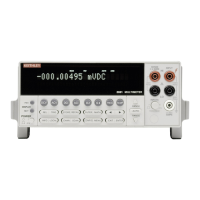Front Panel Operation
3-4
3.2.4 High energy circuit safety precautions
To optimize safety when measuring voltage in high energy
distribution circuits, read and use the directions in the fol-
lowing warning.
WARNING
Dangerous arcs of an explosive nature
in a high energy circuit can cause severe
personal injury, or death. If the multim-
eter is connected to a high energy circuit
when set to a current range, low resis-
tance range, or any other low imped-
ance range, the circuit is virtually
shorted. Dangerous arcing can result
even when the multimeter is set to a
voltage range if the minimum voltage
spacing is reduced.
When making measurements in high energy circuits, use test
leads that meet the following requirements:
• Test leads should be fully insulated.
• Only use test leads that can be connected to the circuit
(e.g., alligator clips, spade lugs, etc.) for hands-off mea-
surements.
• Do not use test leads that decrease voltage spacing. This
diminishes arc protection and creates a hazardous con-
dition.
Use the following sequence when testing power circuits:
1. De-energize the circuit using the regular installed con-
nect-disconnect device, such as a circuit breaker, main
switch, etc.
2. Attach the test leads to the circuit under test. Use appro-
priate safety rated test leads for this application.
3. Set the multimeter to the proper function and range.
4. Energize the circuit using the installed connect-discon-
nect device and make measurements without discon-
necting the multimeter.
5. De-energize the circuit using the installed connect-dis-
connect device.
6. Disconnect the test leads from the circuit under test.
WARNING
The maximum common-mode voltage
(voltage between INPUT LO and chas-
sis ground) is 500V peak. Exceeding this
value may cause a breakdown in insula-
tion, creating a shock hazard.
3.2.5 Power-on default conditions
Power-on default conditions are those conditions the instru-
ment assumes when it is first turned on. You can change these
power-on default conditions (except the primary address) by
using the save setup feature that is available with the MENU
key, as described in paragraph 3.12.1. Depending on the in-
stalled memory option, either one, five, or ten user-defined
setups can be stored, any one of which could be selected as
the power-on default.
A table in paragraph 3.12.1 lists the default conditions that
are set at the factory to optimize bench and GPIB (IEEE-
488) operation.
3.2.6 Warm-up period
The Model 2001 can be used within one minute after it is
turned on. However, the instrument should be turned on and
allowed to warm up for at least one hour before use to
achieve rated accuracy.
3.2.7 IEEE-488 primary address
The IEEE-488 primary address of the instrument must be the
same as the primary address you specify in the controller’s
programming language. The default primary address of the
instrument is 16, but you can set the address to any value
from 0 to 30 by using the MENU key. Refer to paragraph
3.12.2 for step-by-step instructions on setting the primary
address. Section 4 contains details on using the Model 2001
over the IEEE-488 bus.
3.3 Display
The display of the Model 2001 is primarily used to display
readings along with the units and type of measurement.
When not displaying readings, it is used for informational
messages, such as menu headings and selections. At the top
of the display are annunciators to indicate various states of
operation.
3.3.1 Display format
As shown in Figure 3-1, the front panel has two lines of dis-
play information:

